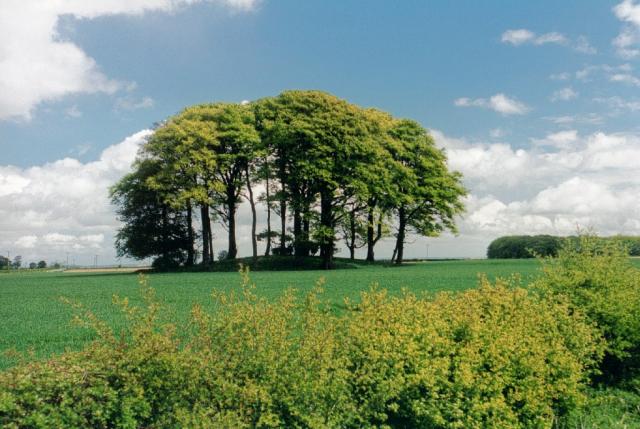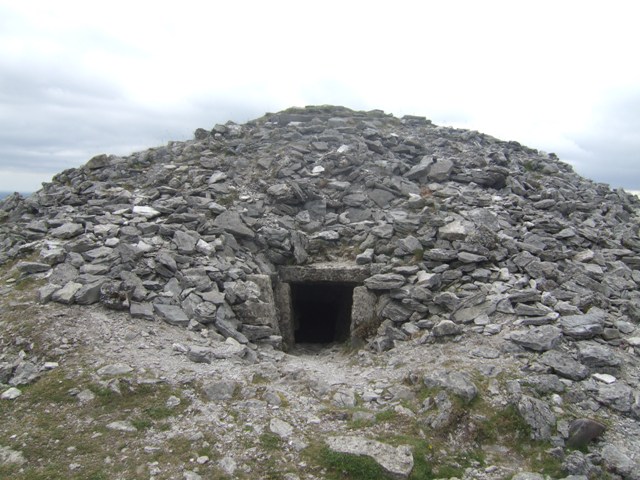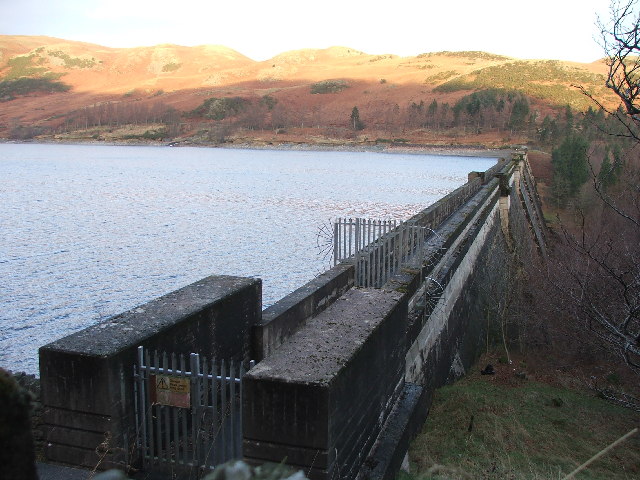|
Harter Fell (Mardale)
Harter Fell is a fell in the far eastern part of the English Lake District. The summit at lies the meeting point of three ridges, and Harter Fell forms the head of three valleys: Mardale, Longsleddale and the valley of the River Kent. Topography In plan section the summit area forms a horseshoe, open to the south east. This ridge is narrow and grassy, with a relatively new fence in place. There are subsidiary tops on both horns of the horseshoe. The southern ridge passes over The Knowe and then Brown Howe, before connecting to Kentmere Pike. The eastern branch includes the rocky top of Little Harter Fell (), and Adam Seat () which is marked by a prominent boundary stone. This ridge continues down to Gatescarth Pass before rising again to Branstree. Connecting to the centre of the summit horseshoe, producing a shape not unlike a tuning fork in plan, is Harter Fell's third ridge. This starts lower down the fell-side and cannot be seen from the summit. This ridge is all toge ... [...More Info...] [...Related Items...] OR: [Wikipedia] [Google] [Baidu] |
High Street (Lake District)
High Street is a fell in the English Lake District. At , its summit is the highest point in the far eastern part of the national park. The fell is named after the Roman road that ran over the summit. History Roman road A Roman road, a scheduled monument, crosses the fell between Roman forts at Brougham ('' Brocavum'') near Penrith and Ambleside ('' Galava'').B Conduit, ''Lake District Walks'' (Norwich 1991) p. 65 Although the route takes the road higher than any other Roman road in England, the High Street range has quite gentle slopes and a flat summit plateau, characteristics that may have persuaded Roman surveyors to build the road over the fell tops rather than through the valleys which were densely forested and marshy making them susceptible to ambush. There has been speculation that the Romans made use of a prehistoric trackway. The nature of the Roman road remains problematic, as much of it is sunken in a hollow, rather than being built on top of an embankment or ... [...More Info...] [...Related Items...] OR: [Wikipedia] [Google] [Baidu] |
Nan Bield Pass
Hill passes of the Lake District were originally used by people in one valley travelling to another nearby without having to go many miles around a steep ridge of intervening hills. Historically, in the Lake District of northwest England, travel on foot or by pony was difficult because of the region's steep-sided valleys so tracks across the ridges were created taking the easiest route over passes – often, but not always, via a col. Since Roman times long-distance travel had tended to be along ridges. From the 19th century these passes and ridge routes were brought back into use when recreational hill walking become popular. Forty hill passes within the Lake District National Park are listed here, using criteria for selecting the major routes. Background The Lake District National Park was created in 1951 covering an area of over and, although its population is only 42,000, over 10 million visitors arrive each year, mostly attracted by the lakes and fells. Geology About ... [...More Info...] [...Related Items...] OR: [Wikipedia] [Google] [Baidu] |
Relative Height
In topography, prominence or relative height (also referred to as autonomous height, and shoulder drop in US English, and drop in British English) measures the height of a mountain or hill's summit relative to the lowest contour line encircling it but containing no higher summit within it. It is a measure of the independence of a summit. The key col ("saddle") around the peak is a unique point on this contour line and the ''parent peak'' (if any) is some higher mountain, selected according to various criteria. Definitions The prominence of a peak is the least drop in height necessary in order to get from the summit to any higher terrain. This can be calculated for a given peak in the following manner: for every path connecting the peak to higher terrain, find the lowest point on the path; the ''key col'' (or ''highest saddle'', or ''linking col'', or ''link'') is defined as the highest of these points, along all connecting paths; the prominence is the difference between the ... [...More Info...] [...Related Items...] OR: [Wikipedia] [Google] [Baidu] |
Marilyn (hill)
This is a list of Marilyn hills and mountains in the United Kingdom, Republic of Ireland, Ireland and surrounding islands and Stack (geology), sea stacks. Lists of mountains and hills in the British Isles#Marilyns, Marilyns are defined as peaks with a topographic prominence, prominence of or more, regardless of height or any other merit (e.g. topographic isolation, as used in Lists of mountains and hills in the British Isles#Munros, Munros). Thus, Marilyns can be mountains, with a height above , or relatively small hills. there were 2,010 recorded Marilyns. Definition The Marilyn classification was created by Alan Dawson in his 1992 book ''The Relative Hills of Britain''. The name Marilyn was coined by Dawson as a punning contrast to the ''Munro'' classification of Scottish mountains above , but which has no explicit prominence threshold, being homophone, homophonous with (Marilyn) ''Marilyn Monroe, Monroe''. The list of Marilyns was extended to Ireland by Clem Clements. Ma ... [...More Info...] [...Related Items...] OR: [Wikipedia] [Google] [Baidu] |
A Pictorial Guide To The Lakeland Fells
''A Pictorial Guide to the Lakeland Fells'' is a series of seven books by A. Wainwright, detailing the fells (the local word for hills and mountains) of the Lake District in northwest England. Written over a period of 13 years from 1952, they consist entirely of reproductions of Wainwright's manuscript, hand-produced in pen and ink with no typeset material. The series has been in print almost continuously since it was first published between 1955 and 1966, with more than 2 million copies sold. It is still regarded by many walkers as the definitive guide to the Lakeland mountains. The 214 fells described in the seven volumes have become known as the Wainwrights. the LDWA register of those who have climbed all the fells listed 674 names. The Wainwright Society maintains a "register of current Society members who have climbed all 214 fells". First editions The first five books were originally published by Wainwright's friend, Henry Marshall, Chief Librarian of Kendal and We ... [...More Info...] [...Related Items...] OR: [Wikipedia] [Google] [Baidu] |
Alfred Wainwright
Alfred Wainwright Order of the British Empire, MBE (17 January 1907 – 20 January 1991), who preferred to be known as A. Wainwright or A.W., was a British fellwalking, fellwalker, guidebook author and illustrator. His seven-volume ''Pictorial Guide to the Lakeland Fells'', published between 1955 and 1966 and consisting entirely of reproductions of his manuscript, has become the standard reference work to 214 of the fells of the English Lake District. Among his 40-odd other books is the first guide to the Coast to Coast Walk, a long-distance footpath devised by Wainwright which remains popular today. Life Alfred Wainwright was born in Blackburn, Lancashire, into a family which was relatively poor, mostly because of his stonemason father's alcoholism. He did very well at school (first in nearly every subject) although he left at the age of 13. While most of his classmates were obliged to find employment in the local mills, Wainwright started work as an office boy in Blackburn ... [...More Info...] [...Related Items...] OR: [Wikipedia] [Google] [Baidu] |
Cairn
A cairn is a human-made pile (or stack) of stones raised for a purpose, usually as a marker or as a burial mound. The word ''cairn'' comes from the (plural ). Cairns have been and are used for a broad variety of purposes. In prehistory, they were raised as markers, as memorials and as burial monuments (some of which Chambered cairn, contained chambers). In the modern era, cairns are often raised as landmarks, especially to mark the summits of mountains, and as Trail blazing, trail markers. They vary in size from small piles of stones to entire artificial hills, and in complexity from loose conical rock piles to elaborate megalithic structures. Cairns may be painted or otherwise decorated, whether for increased visibility or for religious reasons. History Europe The building of cairns for various purposes goes back into prehistory in Eurasia, ranging in size from small rock sculptures to substantial human-made hills of stone (some built on top of larger, natural hills). ... [...More Info...] [...Related Items...] OR: [Wikipedia] [Google] [Baidu] |
Ill Bell
Ill Bell is a fell in the English Lake District, in the county of Cumbria, standing on the narrow ridge between the valleys of Kentmere and Troutbeck. Topography To the north is Froswick, a strikingly similar lesser copy, while the adjoining fell to the south is Yoke. Ill Bell appears from some directions to be a perfectly symmetrical bell-shaped peak, and 'Hill Bell' is one possible derivation of the name, quoted by Alfred Wainwright.Alfred Wainwright:''A Pictorial Guide to the Lakeland Fells'', Book 2: With this form aped by Froswick, the ridge assumes an unmistakable 'roller-coaster' appearance when viewed in profile. The western side is steep and relatively smooth, falling not direct to the Troutbeck valley but to its main tributary, Hagg Gill. The low top of Troutbeck Tongue stands between the two valleys. The eastern Kentmere flank is rougher and steeper, falling in a great tumble of scree to the shore of Kentmere Reservoir. There is the hint of a ridge to the north-ea ... [...More Info...] [...Related Items...] OR: [Wikipedia] [Google] [Baidu] |
Head Of The Reservoir
In hydrology, the head is the point on a watercourse up to which it has been artificially broadened and/or raised by an impoundment. Above the head of the reservoir natural conditions prevail; below it the water level above the riverbed has been raised by the impoundment and its flow rate reduced, unless and until banks, barrages, weir sluices or dams are overcome (overtopped), whereby a less frictional than natural course will exist (mid-level and surface rather than bed and bank currents) resulting in flash flooding below. In principle, a distinction must be drawn between the head of a reservoir impounded by a dam, and the head of a works resulting from a barrage or canal locks. Head of a reservoir A head's location varies with the height of the water level against the dam. Since there is only an extremely low flow within the reservoir so no water level gradient, the head can be clearly seen: where the farthest watercourse discharges into the reservoir. Upstream of the ... [...More Info...] [...Related Items...] OR: [Wikipedia] [Google] [Baidu] |
Haweswater Reservoir
Haweswater is a reservoir in the valley of Mardale, Cumbria in the Lake District, England. Work to raise the height of the original natural lake was started in 1929. It was controversially dammed after the UK Parliament passed a local act of Parliament, the Manchester Corporation Act 1919 ( 9 & 10 Geo. 5. c. cxix), giving Manchester Corporation permission to build the reservoir to supply drinking water to the city. The decision caused a public outcry because the farming villages of Measand and Mardale Green would be flooded and the valley altered forever. The reservoir is now owned by United Utilities. It supplies about 25% of the North West's water supply. Etymology Haweswater is derived from Old Norse or Old English. 'Hafr's lake' refers to the personal Norse name 'Hafr' or in Old English 'Hæfer'; 'water' or 'wæter' is the dominant term for 'lake' in old English. Geology Haweswater is the location of a caldera volcano succession. History Haweswater was originally ... [...More Info...] [...Related Items...] OR: [Wikipedia] [Google] [Baidu] |
Mountain Passes
A mountain pass is a navigable route through a mountain range or over a ridge. Since mountain ranges can present formidable barriers to travel, passes have played a key role in trade, war, and both human and animal migration throughout history. At lower elevations it may be called a hill pass. A mountain pass is typically formed between two volcanic peaks or created by erosion from water or wind. Overview Mountain passes make use of a gap, saddle, col or notch. A topographic saddle is analogous to the mathematical concept of a saddle surface, with a saddle point marking the minimum high point between two valleys and the lowest point along a ridge. On a topographic map, passes can be identified by contour lines with an hourglass shape, which indicates a low spot between two higher points. In the high mountains, a difference of between the summit and the mountain is defined as a mountain pass. Passes are often found just above the source of a river, constituting a drai ... [...More Info...] [...Related Items...] OR: [Wikipedia] [Google] [Baidu] |
Cirque
A (; from the Latin word ) is an amphitheatre-like valley formed by Glacier#Erosion, glacial erosion. Alternative names for this landform are corrie (from , meaning a pot or cauldron) and ; ). A cirque may also be a similarly shaped landform arising from fluvial erosion. The concave shape of a glacial cirque is open on the downhill side, while the cupped section is generally steep. Cliff-like slopes, down which ice and glaciated debris combine and converge, form the three or more higher sides. The floor of the cirque ends up bowl-shaped, as it is the complex convergence zone of combining ice flows from multiple directions and their accompanying rock burdens. Hence, it experiences somewhat greater erosion forces and is most often overdeepening, overdeepened below the level of the cirque's low-side outlet (stage) and its down-slope (backstage) valley. If the cirque is subject to seasonal melting, the floor of the cirque most often forms a tarn (lake), tarn (small lake) behind a d ... [...More Info...] [...Related Items...] OR: [Wikipedia] [Google] [Baidu] |







